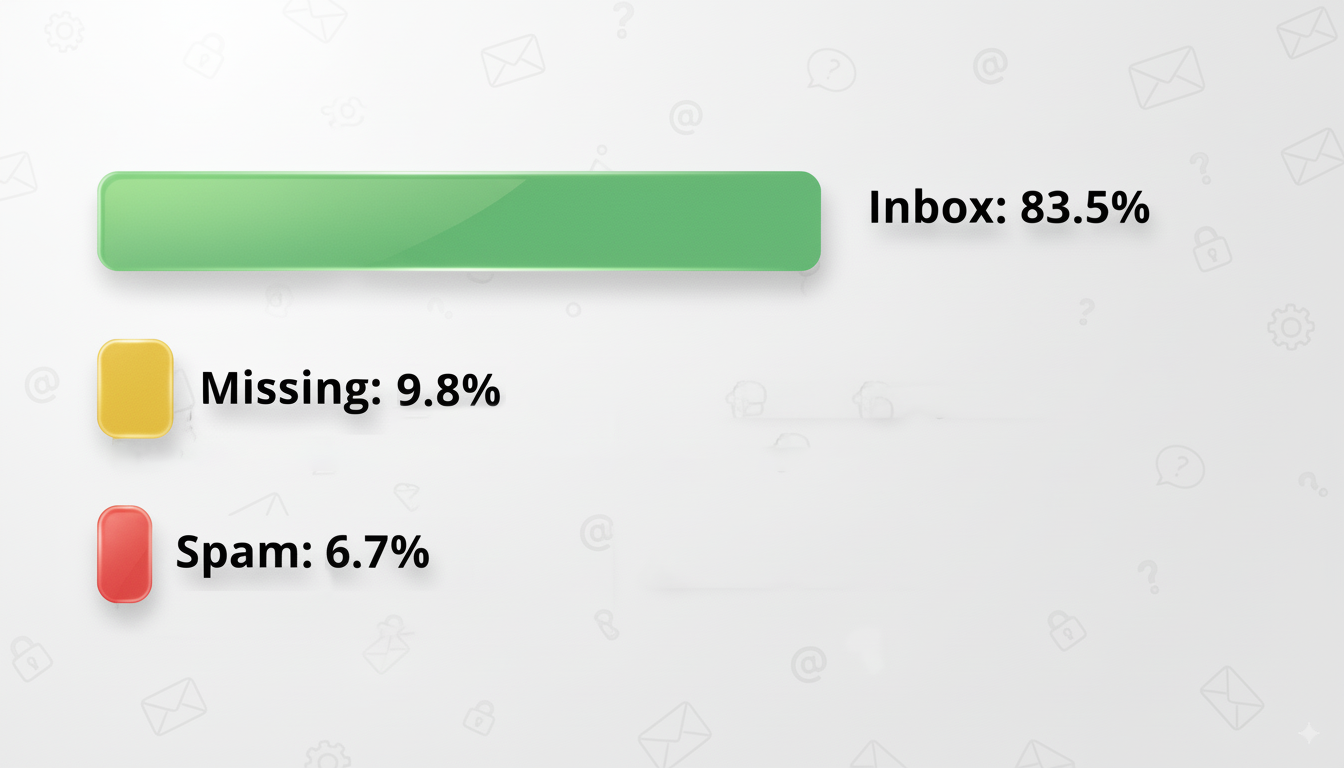Why Your Emails Aren’t Reaching Inboxes and How to Improve Deliverability

Table of Contents
If your emails are not landing in inboxes, you are not just missing engagement opportunities but also weakening your overall campaign performance. In 2025, email marketing continues to be one of the most cost-effective channels to reach customers, in which nearly 16.9% of marketing emails fail to reach the inbox, often ending up in spam or being blocked due to poor deliverability. In this article, we will explain why this happens and how you can improve your email deliverability.
What Is Email Deliverability?
⭐
Email deliverability means your emails successfully reach your intended inbox instead of being marked as spam and sent to the junk folder.
⭐
It is not just about sending the email. It is about ensuring emails arrive in the inbox where your audience is most likely to notice them.
Importance of Email Deliverability in 2025
By 2025, strong email deliverability is essential for reaching your audience. Email providers like Gmail, Outlook, and Yahoo evaluate not only the content of your emails, but also look at:
●
How often your emails are opened
●
Whether users interact with or delete them
●
Your bounce rate and spam complaint rate
If your sending behavior appears to be suspicious, your entire domain/IP can be flagged, which can harm your email deliverability. Simply poor deliverability reduces the effectiveness of your campaign efforts and limits your return on investment.
Email Deliverability Insights
The Email Deliverability Benchmark report indicates that only 83.5% marketing emails end up in the inbox, while 6.7% are filtered to spam, and 9.8% go undelivered altogether. It suggests that approximately 1 in 5 emails fail to reach your target audience, resulting in a costly outcome for any business that relies on email marketing.

6 Reasons Why Your Emails Aren’t Reaching Inboxes
Let us discuss the most common causes for emails not reaching inboxes:
1. Poor Email List Hygiene
Poor email list hygiene is sending emails to invalid or inactive email addresses, which leads to high bounce rates. Also, it damages your sender's reputation with email providers.
2. Spammy Content
Using spammy content such as excessive exclamation marks, phrases like “Free!!!” or “Buy Now,” all-caps subject lines, or emails overloaded with images and little text can trigger spam filters.
3. Lack of Authentication Records (SPF, DKIM, DMARC)
A lack of proper authentication records, like SPF, DKIM, and DMARC, is one of the most overlooked reasons why emails are flagged as spam, even if you are a legitimate sender. These email authentication protocols help verify your identity to mailbox providers and protect both senders and recipients from spoofing, phishing, and impersonation.
4. High Bounce Rates
A high bounce rate signals to email providers that you may be sending to invalid or disposable email addresses.
●
Hard bounces mean the address is permanently invalid (e.g., it doesn’t exist or the domain is wrong).
●
Soft bounces are temporary failures (e.g., mailbox full, server issues).
Both can damage your sender's reputation and cause future emails to be filtered or blocked.
5. Low Engagement Signals
Low engagement signals when recipients consistently ignore, delete, or mark your emails as spam, which can lead mailbox providers like Gmail to filter out emails to the spam folder.
6. Not Using a Reputable Sending Domain or IP
Using a shared IP address or a sending domain with a poor reputation can put your deliverability at risk, so it is important to use a dedicated IP address.
Tips to Improve Email Deliverability
Follow these best practices to ensure your emails consistently reach the inbox.
1. Verify Emails Before Sending
If you already have an existing subscriber list, use a bulk email verifier to clean it before sending campaigns. This process removes invalid addresses, spam traps, and other harmful contacts that could hurt your sender's reputation.
For new sign-ups, integrate a real-time email validation widget into your forms to block invalid or mistyped addresses at the point of entry.
2. Use Double Opt-In
Double Opt-In includes a verification stage in which the subscriber validates their email address before being added to your list. This reduces invalid or mistyped entries, protects your sender's reputation, and ensures only interested people subscribe using double opt-in, which improves delivery rates. While it may slightly lower the list size, it gradually enhances engagement and inbox placement.
3. Monitor Your Sender Reputation
Monitoring your sender reputation is crucial for maintaining strong email deliverability, as it informs inbox providers whether to accept your messages. Like a credit score, a weak sender reputation can cause even well-crafted emails to end up in spam or get blacklisted altogether. Using a free blacklist checker, you can quickly check if your domain or IP is flagged and take action before it affects your campaigns.
4. Segment and Personalize
Send relevant content to targeted groups rather than blasting your full list. Personalized subject lines and content can boost open rates by over 26%.
5. Set Up Email Authentication (SPF, DKIM, DMARC)
Proper email authentication helps mailbox providers verify that you are a legitimate sender and prevents your email from being spoofed. Without it, even genuine emails can end up in spam.
●
SPF (Sender Policy Framework) helps email providers confirm that the server sending your emails is allowed to use your domain name. If a message comes from a server not listed in your SPF record, it may be rejected or flagged as suspicious. To secure your domain, use a free SPF record generator for proper configuration.
●
DKIM (DomainKeys Identified Mail) makes sure every outgoing message is signed by DKIM. Then check this signature is matched against a public key stored in your domain’s DNS. If it matches, it proves the email really came from your domain and the email content is intact and has not been tampered with.
●
DMARC (Domain-based Message Authentication, Reporting & Conformance) builds on SPF and DKIM by telling receiving mail servers how to handle emails that fail authentication. It also provides detailed reports to monitor who is sending emails from your domain.
6. Avoid Sending to Inactive Subscribers
Remove users who haven’t opened the email in the last 90–120 days. Reach out with a re-engagement campaign to confirm whether subscribers still want to receive your emails.
While all of these strategies can strengthen deliverability, one of the most effective ways to protect your sender reputation is to prevent invalid email addresses from being added to your list. Real-time email validation tool streamlines this process and ensures accuracy.
Bottom Line
High email deliverability doesn’t happen overnight. It is built through consistent list cleaning, solid authentication, and smart sending practices. Verifying every address before it is added to your list and verifying your existing email list using bulk email validation is the simplest way to protect your sender reputation and reach more real inboxes. With ExactVerify, you can make that happen automatically.
Frequently Asked Questions (FAQs) on Email Deliverability
1. Why do my emails go to spam even if my list is opt-in?
Even with opt-in subscribers, poor email authentication, spam-triggering words, high bounce rates, or low engagement can cause mailbox providers to filter your emails into spam. Consistently monitoring your sender reputation and following deliverability best practices helps avoid this.
2. How often should I clean my email list?
For best results, clean your list always before launching a major campaign. This removes invalid or disposable addresses that could harm your email deliverability.
3. Do SPF, DKIM, and DMARC improve deliverability?
Yes. These protocols authenticate your emails, proving to mailbox providers that they are coming from an authorized source. Without them, even legitimate emails can be marked as suspicious or rejected.
4. How can I check if my domain or IP is blacklisted?
Use a blacklist checker tool to see if your sending IP or domain is flagged. Regular checks allow you to take preventive actions before blacklist issues impact your email campaigns.
